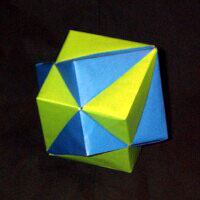There are a number of attractive polyhedron compounds of two cubes. The first (left figures) is obtained by allowing two cubes
to share opposite polyhedron vertices then rotating
one a sixth of a turn about a axis (Holden 1991, p. 34). A second (middle figures)
combines two cubes rotated
with respect to one another along a
axis. A third (right figure) consists of two cubes rotated
by
with respect to each other around a common
axis.
These compounds are implemented in the Wolfram Language as PolyhedronData["CubeTwoCompound",
n
]
for
,
2, 3.
The
compound appears twice (in the lower left as a beveled wireframe and in the lower
center as a solid) in M. C. Escher's 1948 wood engraving "Stars"
(Forty 2003, Plate 43).
These cube 2-compounds are illustrated above together with their octahedron 2-compound duals and common midspheres.

|
|
The left illustration above shows an origami cube 2-compound (Brill 1996, pp. 90-92).
The right illustration shows the net of one pyramid of the compound. Each pyramidal
portion is composed of two doms (1-2 right triangles) and
one isosceles right triangle. If the original cube has edge lengths 1, then edge
lengths of the net are given by
|
(1)
| |||
|
(2)
| |||
|
(3)
| |||
|
(4)
|
The surface area of the hull of the first compound is
|
(5)
|
compared to
for each of the two original cubes. Rather surprisingly, the surface area of the
compound is therefore a rational number.
For the first compound, the common solid is a hexagonal dipyramid and the convex hull is an elongated hexagonal dipyramid, while for the second, the common solid and convex hull are both octahedral prisms.

If a second cube is rotated about a axis with respect to a fixed cube, then the edges indicated
in black above remain intersecting throughout the entire 1/3 turn. The
-position of the intersection as a function of rotation angle
is given by the complicated expression
![x=(12costheta-3cos(2theta)-sqrt(3)[4sintheta+sin(2theta)])/(2[6+2costheta+cos(2theta)-2sqrt(3)(costheta-1)sintheta]).](/images/equations/Cube2-Compound/NumberedEquation2.svg) |
(6)
|